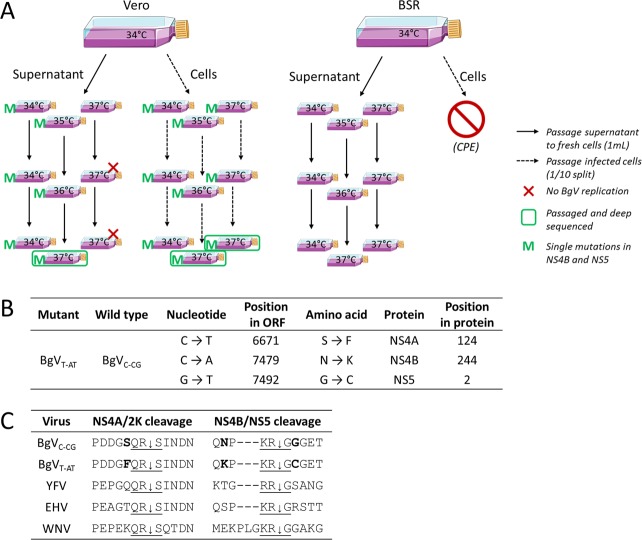Fig 3.
A. Blind passages of BgV in vertebrate cells. Flasks of BSR and Vero cells were inoculated with BgV at MOI 1 and incubated at 34°C for five days. 1mL aliquots of supernatant from these flasks were blindly passaged three times to flasks of freshly seeded cells. Vero cells were split 1/10 and passaged three times, while BSR cells succumbed to cytopathic effect and could not be passaged. At each passage, one set of supernatant and cells was maintained at either 34°C or 37°C, while the third set was incubated at increasing temperatures: 35°C, 36°C and finally 37°C. The presence of BgV in the harvested supernatants was tested by titration on C6/36 cells followed by fixed-cell ELISA. The red crosses represent samples in which BgV was not detected. Three samples were selected for further passaging (circled) and RNA extracts from the resulting supernatants were deep sequenced. The samples marked with a green M carried two of three identified conserved mutations, as determined by Sanger sequencing, in NS4B and NS5. B. The three conserved mutations identified by next-generation sequencing in replication-competent BgV variants. The nomenclature adopted hereafter is BgVC-CG for prototype BgV and BgVT-AT for a BgV variant containing all three NS4A/NS4B/NS5 identified conserved mutations. C. Alignment of selected flaviviruses over two viral protease cleavage sites: NS4A/2K and NS4B/NS5. The bolded letters correspond to the identified mutation sites in BgV sequence. The underlined letters and downward arrow correspond to the viral protease cleavage site.

